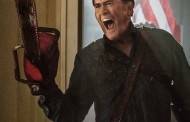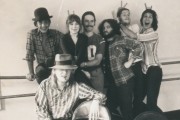 I recently got the chance to see an indie film that I was really impressed by, Nerve. Afterward I had the opportunity to interview writer/director/producer/editor J.R. Sawyers. Nerve is Sawyers’ first feature, though he has experience acting in films and writing/directing short films. Because of that, I focused on asking questions about how he managed to pull off the difficult task of directing his first feature-length film. What resulted was an interview that not only goes into detail about Nerve, but turned into a virtual “how-to” guide full of tips for anyone wanting to shoot a film.
I recently got the chance to see an indie film that I was really impressed by, Nerve. Afterward I had the opportunity to interview writer/director/producer/editor J.R. Sawyers. Nerve is Sawyers’ first feature, though he has experience acting in films and writing/directing short films. Because of that, I focused on asking questions about how he managed to pull off the difficult task of directing his first feature-length film. What resulted was an interview that not only goes into detail about Nerve, but turned into a virtual “how-to” guide full of tips for anyone wanting to shoot a film.
Q: You’re primarily an actor, and Nerve is the first feature film you’ve written, produced, edited, or directed — and you did all four! What inspired you to tackle such a project?
A: Actually, I’m primarily a filmmaker. I’ve been writing scripts since high school. And before I ever acted a line, I started to make a low budget movie in New York that fell apart due to lack of funds. I moved to Los Angeles a little over four years ago and Nerve was the first script I wrote out here. There was a few others, including a thriller I wanted to eventually direct. But Nerve seemed the easiest to produce with a shoe string budget considering the story was all about characters rather than expensive set pieces.
Q: What inspired you to make a film about a character with social anxiety?
A: That came out of a natural development in the writing process. The initial idea of Nerve came after I saw the film There Will Be Blood. I not only wanted to write a character study, but I also wanted the character to have a giant arc. I had the idea of a very fearful young man, who through various experiences, ends up on the other extreme in which his fearlessness is actually harmful to himself. While researching, I discovered that 8% of the population had social phobia and considering the role social media has in our lives, that number may go up. To make Josh a real and relative character, I decided to make him crippled by the disorder. And the plot would be how Josh battles it.
Q: Many independent filmmakers swap stories on how they raised money for their films and how they made the film on a tight budget. Any particular budget-related stories you want to share?
A: Sure. I’ll share with you the general plan when it came to financing. Basically that first week of shooting was out of my own pocket. Using the footage we shot from that first week, I created a trailer to show people who had relatively deep pockets. They liked what they saw and gave me more money to shoot a second week. Once that second week was done, I met with more people who in turn gave me the funds to finish the film. There was also donated funds through a fiscal sponsorship I had set up, but that ultimately wound up being a very small total. I don’t recommend this way of shooting at all, since it’s very risky. But it was the only foreseeable method at the time. It just became apparent to me that the only way I can get people’s attention was if I showed them exactly the quality of the production their money can buy.
Q: The cast is made up of actors with a variety of experience. How did you put the cast together for the film?
A: Through the usual online channels used in Los Angeles. We held the auditions at CAZT studios in Hollywood. Thousands submitted, but we wound up only auditioning a few hundred. Tyler Langdon became a clear favorite for the role of Josh because he had a great everyman look and knew how to be real. The same thing was true with the rest of the cast. For Aurora’s character, I wanted an attractive girl who was believable as a psychology student. I also wanted her to be ethnic. I seldom see Hispanic people in roles where they play smart, scientific people on film. Yet in real life, I saw this constantly at Rutgers University. With the homeless people, I wanted to get people who represented all shapes and demographics. Something about a diverse cast is aesthetically pleasing to the eye.
Q: What was the biggest challenge you faced when you were shooting the movie from a storytelling standpoint? In other words, was there anything that worked for you on paper but didn’t work as well on film?
A: Yes. After my first few festival submissions, I noticed people had problems with the very first ending of the film. In script form, it worked well. But in the movie, it just seemed out of place and too surreal. When I came around to seeing their perspective, I couldn’t wait to cut it out. Also, there was a whole subplot in which Josh is missing when the movie begins and a detective is investigating the case. After receiving enough helpful criticism, that also wound up on the cutting floor.
Q: Do you have any advice for aspiring filmmakers who plan, probably not by choice, on shooting a movie under similar budgetary constraints?
A: Yes, before you do anything, talk to your friends and find out what you can get free. That includes locations, props, equipment, etc. Knowing those details may actually force you to rewrite the script, so it’s important to know early on. Second, carefully plan out your shot list before a single frame is shot. If you’re well prepared, you have a better chance at getting the shots within the time you allotted yourself. I was prepared, yet there were many, many shots I never got to shoot. So imagine if I hadn’t created a shot list? Third, if you can, shoot with a RED camera. They shoot at at least a 4k resolution. So if you run out of time to get all your shots, you can often cheat by cropping out closeups that are at full HD. In addition, they are much cheaper to rent now. And lastly, surround yourself with a crew you trust. I was lucky to have a great, professional crew working their butts off for little to no money.
Q: Both Josh and Aurora are fascinating characters that are really elevated by the performances by Tyler Langdon and Laura Alexandra Ramos respectively. Did the characters as you initially saw them change at all once you cast those actors in those roles?
A: Good question. And a definite yes. Tyler surprised me early on by how funny he was. Consequently, Josh became a more entertaining character to watch, specifically in scenes in which he’s trying to break free from his anxiety. This was a blessing since I was trying to avoid the angst many independent films seem to carry. Laura’s take was interesting too. There was a coldness she brought to the character that worked well considering how the plot evolves. In addition, it helps define Josh’s character, which is the ultimate goal of the film.
Q: Could you tell us about the funniest thing that happened on the set?
A: That’s a tough one because there’s many. One moment that jumps out at me is only funny now. This is when we were filming on a residential street and my DP, Josh Maas, had the idea to connect the lighting equipment to a city outlet. This is very illegal and I could’ve ended up with a huge fine. In fact, after our first take, a cop car came out of nowhere and almost shut us down. Luckily, they suddenly got called for something bigger and took off with their sirens on. After that, we did a hurried take and ran off the street with our equipment.
Q: Ultimately how closely does the final product reflect your initial conception of the project?
A: Vastly different. Due to the constraints of the budget, my original 125 page script got cut down to about 90 pages. But the important stuff is still there. It’s just much leaner with a laser focus on Josh’s relationships with Walt Russo (his roommate) and Aurora.
Q: What’s next for you, as both an actor and a filmmaker?
A: As an actor, my first step is getting a new agent. As a filmmaker, it’s to get going on my other scripts again, like the thriller I’ve since had on the shelf. Hopefully, I won’t have to wear so many hats this time!
Thanks again, J.R., and good luck with your future films!
You can find out more information about Nerve here. For more information about J.R. Sawyers, check out his website here.















Recent Comments